North America Dipeptide Peptidase 4 (DPP-4) Inhibitors Market Size
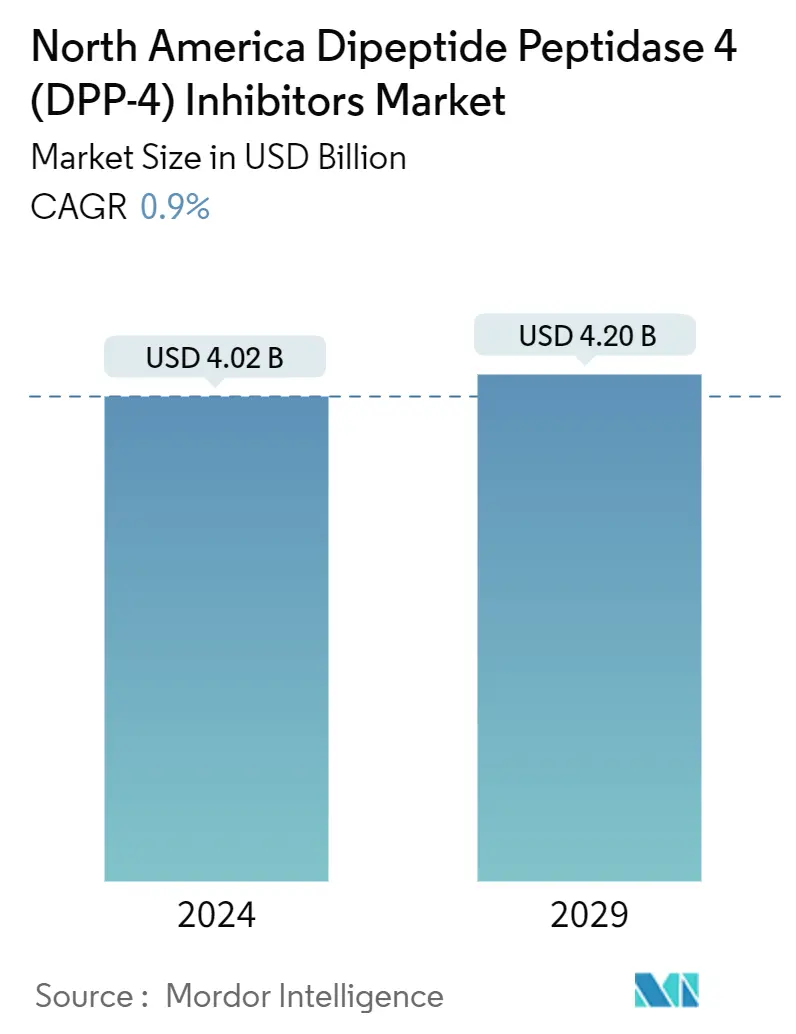
| Study Period | 2021- 2029 |
| Base Year For Estimation | 2023 |
| Market Size (2024) | USD 4.02 Billion |
| Market Size (2029) | USD 4.20 Billion |
| CAGR (2024 - 2029) | 0.90 % |
| Market Concentration | High |
Major Players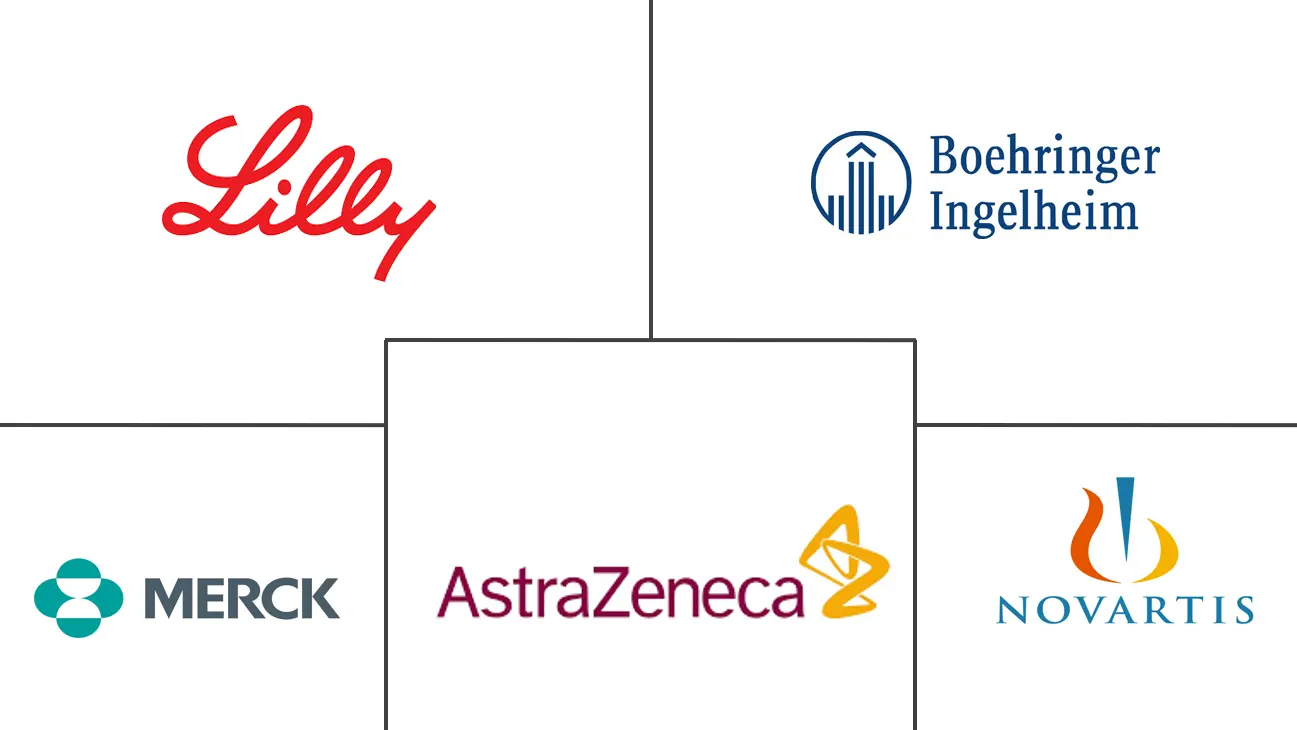
*Disclaimer: Major Players sorted in no particular order |
North America Dipeptide Peptidase 4 (DPP-4) Inhibitors Market Analysis
The North America Dipeptide Peptidase 4 Inhibitors Market size is estimated at USD 4.02 billion in 2024, and is expected to reach USD 4.20 billion by 2029, growing at a CAGR of 0.9% during the forecast period (2024-2029).
Type 2 diabetes emerged as one of the most important and common risk factors for COVID-19 mortality. The risk of COVID-19 mortality was twice as high in people with type 2 diabetes as in those without; studies showed an association between hyperglycemia and increased COVID-19-related mortality in people with type 2 diabetes. The DPP-4 inhibitors were hypothesized to potentially modify the biological activity of various substrates involved in the immune response to the infection, suggesting potential benefit.
Dipeptidyl peptidase 4 (DPP-4) inhibitors are a class of medicine that lowers high blood glucose levels and treat type 2 diabetes. Dipeptidyl-peptidase 4 inhibitors have glucose regulatory actions by prolonging the effects of GLP-1 and GIP, ultimately increasing glucose-mediated insulin secretion and suppressing glucagon secretion. Besides the glucose-lowering properties of DPP4 inhibitors, emerging evidence suggests that incretin-based therapies may also positively impact inflammation, cardiovascular and hepatic health, sleep, and the central nervous system.
According to Diabetes Canada, new 2022 figures show the continued rising trend of diabetes rates in Canada with no signs of leveling or decreasing. Diabetes continues to affect more Canadians than ever before. The new diabetes figures show a steady, continued increase in diabetes in the country, with 11.7 million Canadians living with diabetes or prediabetes. More than 5.7 million Canadians are living with diagnosed diabetes, and people living with diabetes or prediabetes, which, if left unmanaged, can develop into type 2 diabetes.
The World Health Assembly Resolution 2022 recommends the integration of prevention and treatment of diabetes into primary health services, developing pathways for a substantial increase in access to insulin, promoting convergence and harmonization of regulatory requirements for diabetes medicines and technologies, and improving diabetes monitoring and surveillance. Furthermore, it involves the WHO advising the Member States to ensure the uninterrupted treatment of people living with diabetes in humanitarian emergencies. This important milestone provides a global mandate for diabetes efforts for the next decade.
Therefore, owing to the factors above, the studied market is anticipated to grow over the analysis period.
North America Dipeptide Peptidase 4 (DPP-4) Inhibitors Market Trends
Rising diabetes prevalence is likely to boost the market studied over the forecast period.
The diabetes population in the North American region is expected to rise by more than 1% over the forecast period.
The CDC National Diabetes Statistics Report 2022 estimated that more than 130 million adults live with diabetes or prediabetes in the United States. Type 2 diabetes is more common, and diabetes is more consequential among communities of color; those who live in rural areas; and those with less education, lower incomes, and lower health literacy. According to the Division of Metabolism and Endocrinology Products in the FDA's Center for Drug Evaluation and Research, 'Patients want effective treatment options for diabetes that are as minimally intrusive on their lives as possible, and the FDA welcomes the advancement of new therapeutic options that can make it easier for patients to control their condition.'
Dipeptidyl peptidase 4 (DPP-4) inhibitors are effective in the treatment of type 2 diabetes, as they maintain blood glucose levels through the degradation of incretin peptides, glucagon-like peptide 1 (GLP-1), and glucose-dependent insulinotropic polypeptide. Oral Anti-Diabetic Drugs have been available internationally and are recommended for use when escalation of treatment for type 2 diabetes is required along with lifestyle management.
They are typically the first medications used in treating type 2 diabetes due to their wide range of efficacy, safety, and mechanisms of action. They help diabetes patients control their condition and lower the risk of diabetes complications. These agents present the advantages of easier management and lower cost, so they became an attractive alternative to insulin with better acceptance, which enhances adherence to the treatment.
Owing to the rising rate of obesity, growing genetic factors for type-2 diabetes, the increasing prevalence, and the factors above, the market will likely continue to grow.
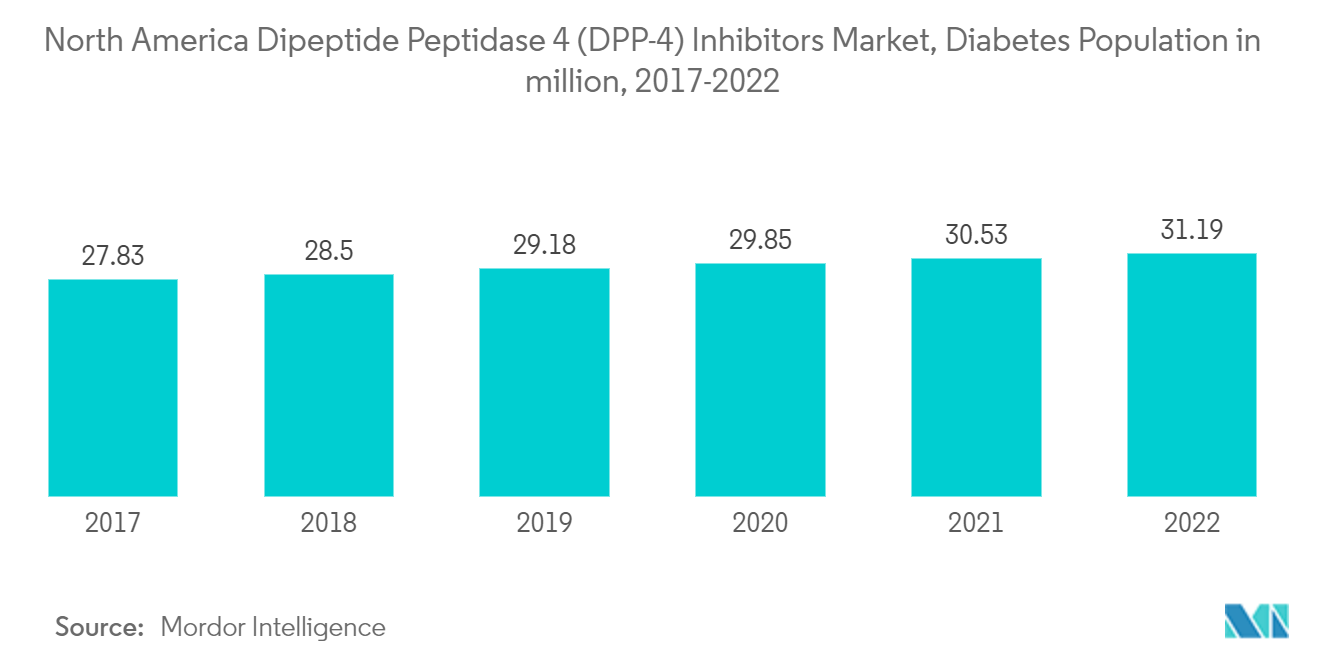
The United States holds the highest market share in the Market
United States holds the highest market share in the North American Dipeptide Peptidase 4 (DPP-4) Inhibitors Market in the current year. It is expected to register a CAGR of about 0.31% over the forecast period.
The disease's growing incidence, prevalence, and progressive nature have encouraged the development of new drugs to provide additional treatment options for diabetic patients. Non-insulin treatments, used as first-line therapies for patients with type 2 diabetes, currently capture more than half the sales in the anti-diabetic market.
Over the past decade, two important classes have entered this market: dipeptidyl peptidase-4 inhibitors (DPP-4) and sodium-glucose cotransporter-2 inhibitors (SGLT-2). These agents work in various ways to reduce blood sugar levels in people with type 2 diabetes; some stimulate insulin secretion by the pancreas, and others improve the responsiveness of cells to insulin or prevent glucose production by the liver. Others slow the absorption of glucose after meals. Also, the use of oral anti-diabetes drugs is rising because new-generation oral drugs, such as DPP-4 and SGLT-2, reduce the rate of CV risk in diabetes patients.
Diabetes medications are covered by most health insurance plans because they are considered medically necessary. Medicare generally covers diabetes medications. The American Diabetes Association has a guide to Medicare and diabetes prescription drug benefits. For patients covered by insurance, typical out-of-pocket costs consist of a prescription drug copay ranging from USD 10 to USD 50, depending on the drug. If the patient takes multiple drugs, copays can total USD 200 monthly or more.
The roll-out of many new products, increasing international research collaborations in technology advancement, and increasing awareness about diabetes among people are some of the market opportunities for the players in the United States market.
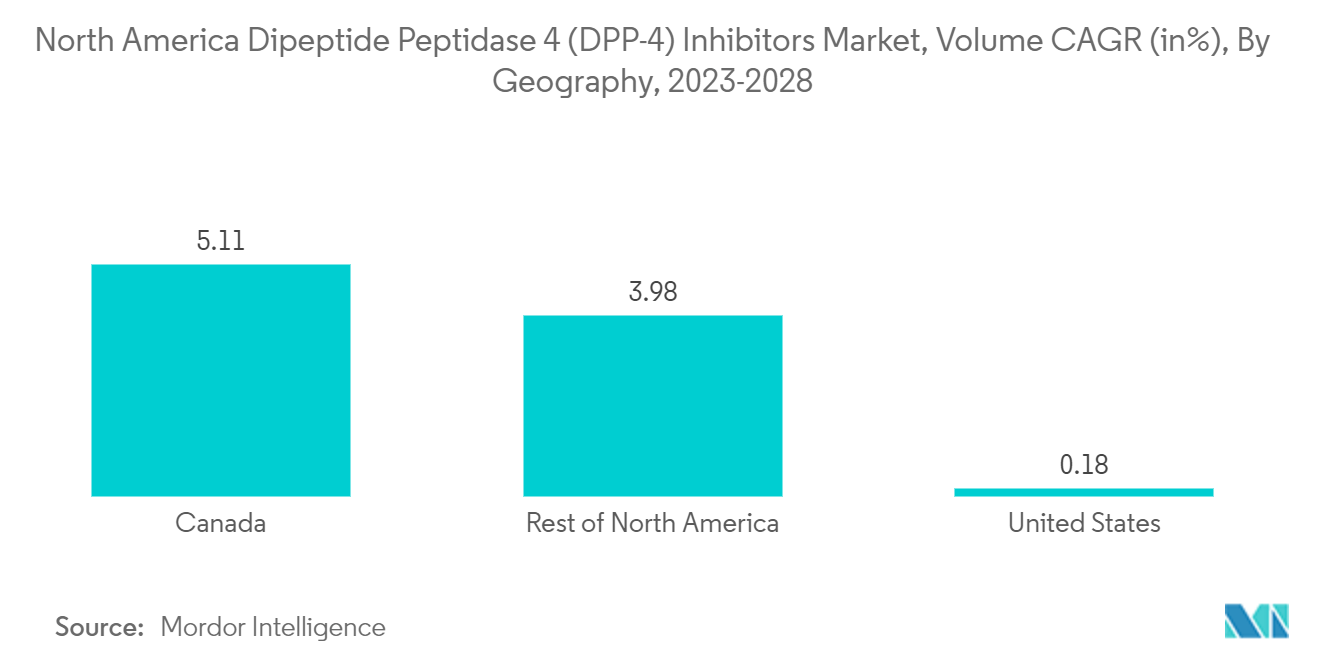
North America Dipeptide Peptidase 4 (DPP-4) Inhibitors Industry Overview
The North American Dipeptide Peptidase 4 (DPP-4) Inhibitors Market is consolidated, with a few major manufacturers like Eli Lilly, AstraZeneca, Merck, Boehringer Ingelheim, and Novartis gaining presence in major countries while the remaining market comprises other local or region-specific manufacturers.
North America Dipeptide Peptidase 4 (DPP-4) Inhibitors Market Leaders
-
Merck
-
AstraZeneca
-
Eli lilly
-
Boehringer Ingelheim Pharmaceuticals Inc.
-
Novartis
*Disclaimer: Major Players sorted in no particular order
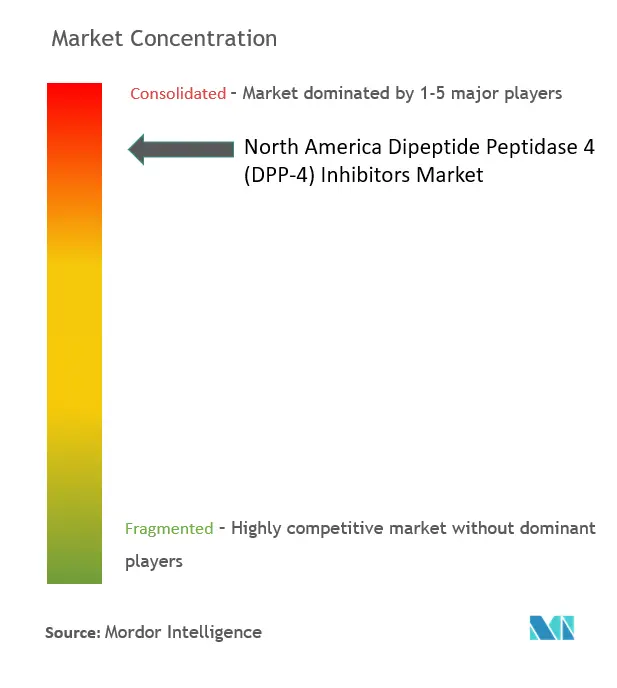
North America Dipeptide Peptidase 4 (DPP-4) Inhibitors Market News
- February 2023: Glenmark Pharmaceuticals Inc. received a 2nd tentative approval by the United States Food & Drug Administration for Saxagliptin Tablets, 2.5 mg, and 5 mg, the generic version of Onglyza Tablets, 2.5 mg and 5 mg, of AstraZeneca.
- February 2022: Eurofarma launched Suganon (evogliptin) in Latin America, an innovative therapy for type 2 diabetes patients. Suganon (evogliptin) is a new DPP-4 enzyme inhibitor, which features the benefits of offering convenient dosing, as well as having a low potential for interaction with other medications, ensuring greater ease and safety for prescribers and type 2 diabetes patients.
North America DPP-4 Inhibitors Market Report - Table of Contents
1. INTRODUCTION
- 1.1 Study Assumptions and Market Definition
- 1.2 Scope of the Study
2. RESEARCH METHODOLOGY
3. EXECUTIVE SUMMARY
4. MARKET DYNAMICS
- 4.1 Market Overview
- 4.2 Market Drivers
- 4.3 Market Restraints
-
4.4 Porter's Five Forces Analysis
- 4.4.1 Bargaining Power of Suppliers
- 4.4.2 Bargaining Power of Consumers
- 4.4.3 Threat of New Entrants
- 4.4.4 Threat of Substitute Products and Services
- 4.4.5 Intensity of Competitive Rivalry
5. MARKET SEGMENTATION
-
5.1 Drugs
- 5.1.1 Januvia (Sitagliptin)
- 5.1.2 Onglyza (Saxagliptin)
- 5.1.3 Tradjenta (Linagliptin)
- 5.1.4 Vipidia/Nesina (Alogliptin)
- 5.1.5 Galvus (Vildagliptin)
-
5.2 Geography
- 5.2.1 United States
- 5.2.2 Canada
- 5.2.3 Rest of North America
6. MARKET INDICATORS
- 6.1 Type-1 Diabetic Population
- 6.2 Type-2 Diabetic Population
7. COMPETITIVE LANDSCAPE
-
7.1 COMPANY PROFILES
- 7.1.1 Merck And Co.
- 7.1.2 AstraZeneca
- 7.1.3 Bristol Myers Squibb
- 7.1.4 Novartis
- 7.1.5 Takeda Pharmaceuticals
- 7.1.6 Eli Lilly
- 7.1.7 Boehringer Ingelheim
- *List Not Exhaustive
- 7.2 COMPANY SHARE ANALYSIS
8. MARKET OPPORTUNITIES AND FUTURE TRENDS
** Subject To AvailablityNorth America Dipeptide Peptidase 4 (DPP-4) Inhibitors Industry Segmentation
Dipeptidyl peptidase 4 (DPP-4) inhibitors are a pharmacological class of drugs for treating type 2 diabetes. They help to control glycemia by increasing the levels of active incretins. The North America Dipeptide Peptidase 4 (DPP-4) Inhibitors Market Is Segmented into Drugs and Geography. The report offers the market size in value terms in USD for all the abovementioned segments. Further, the report will cover a segment-wise breakdown (value and volume) for all the countries covered under the table of contents.
| Drugs | Januvia (Sitagliptin) |
| Onglyza (Saxagliptin) | |
| Tradjenta (Linagliptin) | |
| Vipidia/Nesina (Alogliptin) | |
| Galvus (Vildagliptin) | |
| Geography | United States |
| Canada | |
| Rest of North America |
North America DPP-4 Inhibitors Market Research FAQs
How big is the North America Dipeptide Peptidase 4 Inhibitors Market?
The North America Dipeptide Peptidase 4 Inhibitors Market size is expected to reach USD 4.02 billion in 2024 and grow at a CAGR of 0.9% to reach USD 4.20 billion by 2029.
What is the current North America Dipeptide Peptidase 4 Inhibitors Market size?
In 2024, the North America Dipeptide Peptidase 4 Inhibitors Market size is expected to reach USD 4.02 billion.
Who are the key players in North America Dipeptide Peptidase 4 Inhibitors Market?
Merck, AstraZeneca, Eli lilly, Boehringer Ingelheim Pharmaceuticals Inc. and Novartis are the major companies operating in the North America Dipeptide Peptidase 4 Inhibitors Market.
What years does this North America Dipeptide Peptidase 4 Inhibitors Market cover, and what was the market size in 2023?
In 2023, the North America Dipeptide Peptidase 4 Inhibitors Market size was estimated at USD 3.98 billion. The report covers the North America Dipeptide Peptidase 4 Inhibitors Market historical market size for years: 2021, 2022 and 2023. The report also forecasts the North America Dipeptide Peptidase 4 Inhibitors Market size for years: 2024, 2025, 2026, 2027, 2028 and 2029.
North America Dipeptide Peptidase 4 (Dpp-4) Inhibitors Industry Report
Statistics for the 2024 North America Dipeptide Peptidase 4 (DPP-4) Inhibitors market share, size and revenue growth rate, created by Mordor Intelligence™ Industry Reports. North America Dipeptide Peptidase 4 (DPP-4) Inhibitors analysis includes a market forecast outlook to for 2024 to 2029 and historical overview. Get a sample of this industry analysis as a free report PDF download.



